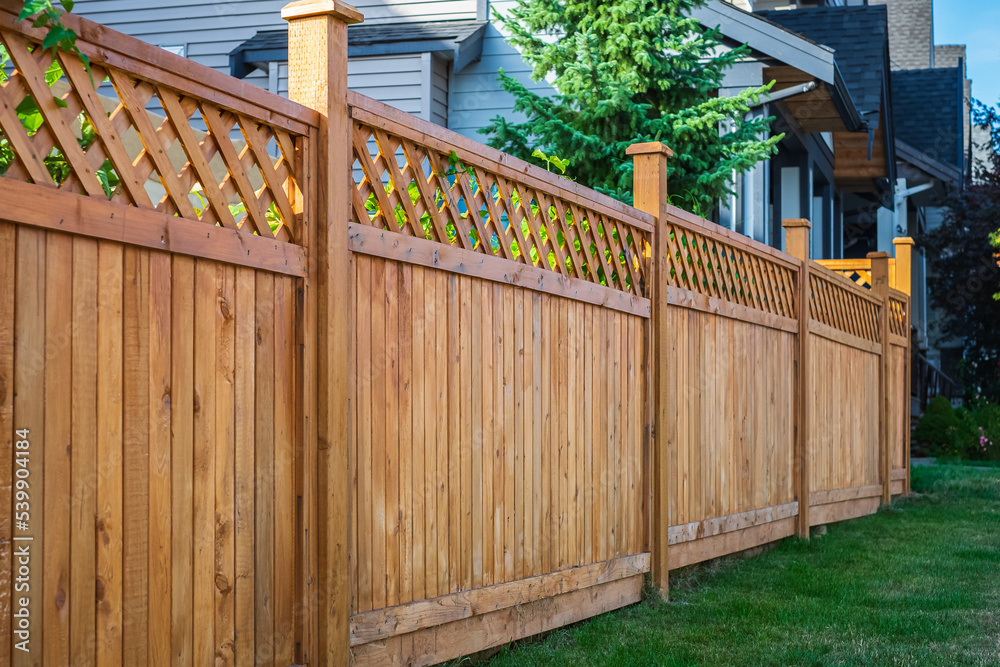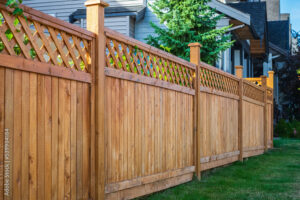
Angled Fences For Homes With Sloped Terrain
If your property has sloped terrain, angled fences are an ideal solution. They can help prevent pets from escaping and keep small children or unwelcome animals out.
Alternating wood boards offer a unique design that looks solid when viewed head-on but offers gaps from other angles. This technique — like clapboard or shiplap siding — complements the home’s contemporary style.

Pro Angle Fencing Summerville is a familiar icon of suburban living. They symbolize the classic dream of a family living in a modest residential home with children, pets, and a sense of community safety. Though they serve a practical purpose, enclosing children and pets in the yard without blocking views or blocking sunlight from the garden, they’re also decorative and allow for plenty of visibility. While they can be built from various materials, including wood and vinyl, most are typically painted white for a classic look that complements many homes.
A variation of this popular style is a shadow box fence, which provides privacy with an interesting design. Like a stockade fence, it has evenly spaced vertical boards called “pickets” attached to horizontal rails. However, it’s different because the rails are wider apart, and gaps are left between alternating pickets, creating a shadowy effect when viewed from a side angle.
To build a shadow box fence, you need a sturdy fence post to support the slats and the angled top. For this reason, the best option is a sturdier wood such as cedar or cypress. These are usually more expensive than pinewood, but they hold up well to weathering and resist rot and insects better than the cheaper varieties of lumber.
You must plan the posts and stringers for the rest of the fence to keep them all even and plumb. Run a line of twine between each corner post and use it as your guide for plumbing the next set of seats down the line. To keep things straight when spacing and nailing the fence boards, you can use a 4-foot level and a spacing block to mark each lineer location. Use a nail gun, such as the Paslode cordless framing nailer, to ensure that each board is securely plumbed and nailed in place.
Another option is to use prefabricated fence panels to save time and money. These are typically sold at home centers and lumberyards and are available in various styles and heights. They’re made from vinyl or wood and snap together to fasten to the posts. Some systems include gates and other high-end hardware.
A classic country fence design, the post and rail fence have a rustic look, providing an effective border for your property. This type of fence is usually used to keep animals contained, but it can also help demarcate boundaries and manage foot traffic. Typically, this type of fence has only two or three horizontal rails between posts from four to 12 feet apart. The rails are often made from a sturdy material like spruce, although more durable materials such as cedar are available at an increased cost.
When building a post and rail fence, you will need to plan. Start with a sketch of the wall, including how high and long you want it to be. It will allow you to calculate the number of posts and rails you need. You will also need to determine if the fencing will require corner posts and a brace.
Next, dig the holes for your fence posts and rails. Most post and rail fences use either square or round wood posts. The holes should be about 6 feet (2 m) apart and deep enough to accommodate the height of your building fence. The rails are then nailed or mortised to the posts. For a mortise, you must create a pocket in the center for the rail to sit.
The posts in a post and rail fence can be any wood, but spruce is commonly used because it is relatively inexpensive and durable. You can also choose to use locust posts, which are more expensive but last longer. If using locust posts, they will need to be treated.
The distance between the posts and rails can vary depending on the appearance you are trying to achieve. Closer spacing will result in a more solid-looking fence, while greater distances will create a lighter visual effect. You may need to purchase pre-made corner posts to join the ends together for longer rails. These are available at most hardware stores and home improvement centers.
There are many factors that homeowners consider when it comes to a fence. They look at the materials, style, and more to choose a wall that will fit their home and meet their needs. But one element often overlooked when building a fence is the height of the wall.
Many municipalities have laws and regulations governing the height of fencing. The rules may vary from town to town, but they usually restrict fence heights to six feet or less. It is to avoid infringing on your neighbor’s property lines. If you are considering a fence taller than the maximum allowed, check with your municipality or homeowners association for more information on rules and regulations.
A flat-height fence can be an excellent choice for homes with sloped yards. However, you should be aware that it can create a uniform gap under the wall in areas where the yard has dips or high spots. It can cause problems with how your yard looks and lead to neighbors complaining if you build your fence close to theirs. You can avoid this issue by getting your property surveyed. A surveyor will mark your property’s boundaries and establish a property line that you can use to locate your fence.
You can choose raked or stepped fencing to avoid a sloping fence that creates uniform gaps. Raked fencing follows the slope of the land and allows for a gradual increase in height, while stepped fencing builds the wall in steps, which can be steeper. Whichever type of fence you choose, you will need to dig a hole three times the post’s diameter and as deep as a third of the height of the bar. You can use a post-hole digger to search your spots, but make sure you follow the correct depth and that your posts are plumb before continuing.
Before deciding on the height of your fence, you should consider its purpose. For example, if you are looking to contain pets or children, you should look for a tall wall to prevent them from jumping or climbing over it. A basic 4-6 foot fence will provide this, but you can go higher to deter motivated burglars.
Retaining walls are everywhere, including along roadways, which help stabilize hillsides and prevent landslides. They’re also used for landscaping and to reshape sloped property, like in the yards of many homes. These walls are designed to keep soil from spilling down a hillside and can be constructed using a wide range of materials.
Whether a retaining wall will last for decades or just a few years depends on what’s happening behind the surface, especially drainage. Without proper drainage, a wall can be overwhelmed by water and eventually fail, much like a failing home foundation would. That is why ensuring a retaining wall has a sound footing and adequate drainage to prevent backfill is essential.
The most common retaining walls are made from timber, concrete, or block. A retaining wall made from wood is the cheapest and easiest to build, but it may last less time than other walls. Pressure-treated pine or fir rated for ground contact should last up to 40 years, while western red cedar can last about 20. Concrete and masonry walls are often more expensive, but they can be more durable and attractive than timber.
When you choose a concrete or masonry retaining wall, it’s important to use local materials whenever possible to reduce the material’s embodied energy. All retaining walls are made from heavy materials; shipping them over long distances increases the resulting carbon footprint. A retaining wall can be made from blocks, boulders, or even bricks, but interlocking concrete is an excellent choice for both residential and commercial properties.
If your home is built on a sloped lot with different slope angles, consider installing a wood-angled fence panel for your yard. This style of fence can be stain-painted to match your home’s color palette, and it’s a great option for homeowners with uneven backyards.

